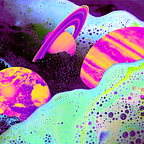In the 1970s, Body Art Became a Symbol of Women’s Freedom — and It Changed Tattooing Forever
And yet, despite the influx of women on the receiving end of fresh ink, there were still very few holding the needle…
“From the late 1970s and through the 1980s, musicians embraced tattoos, especially those in the genres of heavy metal and punk. Motorcycle enthusiasts and bikers became particular adopters of heavy and visible tattooing, which added to the public perception in the late 20th century of tattoos as marks of a socially transgressive nature.” — Anna Felicity Friedman, author of The World Atlas of Tattoos.
Don Ed Hardy was one of the most influential tattoo artists of the 70s. He said of the time, “I came out of the 60s, and we were just fighting for acceptance or recognition on any level whatever it was, you know, race, gender, everything. I hated that tattooing was just looked down on as this scumbag thing. I wanted to fight that fight, [to say] that the amount of ink in your skin didn’t automatically reduce your brain cells.”
Janis Joplin was famously tattooed by Lyle Tuttle in 1970 and it made the front cover of Rolling Stone magazine. She said, “I wanted some decoration. See, the one on my wrist is for everybody; the one on my tit is for me and my friends. Just a little treat for the boys, like icing on the cake.”
Demand for tattoos in the 70s surged to an all-time high — driven by hippies, feminists, mystics, musicians and bikers. (So clearly a very diverse mix of designs.) “Tattoos became bigger and more intricate in the 70s. People started to get full sleeves tattooed, and the artwork itself became more detailed, including elements like shading and depth. Members of “seedy” groups like biker gangs rocked skeletons and Grim Reapers, while hippies rocked fairies and space-themed tats,” according to InkBox.
“The ’70s were a brilliant time for tattoo artists, both male, and female. The inclusion into the world of fine art afforded artists a new opportunity,” according to Tattoo. “They were able to break free of the stereotypical chains which tied them to the less desirable population they had long been associated with. Tattooing became acceptable on a more cultured level, seeing higher-class citizens flocking to tattoo parlours and everyone from lawyers, models, and mothers going under the needle.”
The women’s movement was gaining huge momentum in the US and Europe. As a result, women were successfully challenging the traditional gender roles and choosing careers over marriage. Not surprisingly, divorce became more common – and tattoos became a symbol of women’s freedom. Ruth Marten, a tattoo artist during the 1970s said many of her clients were women getting a divorce. One client told her she “wanted to be able to change her body to something that her ex-husband had had no experience with,” according to Time.
The influx of women in tattooing began to change the industry. “As more women began getting inked and more women began to join the industry, softer, more pastel colours began to creep into the artwork being portrayed. High contrast work began to surface more and more, battling for dominance with the representational work that had commanded the tattoo culture for so long. An art form that was once was filled with hula girls, naval stars, and daggers became flooded with art deco designs and reproductions of famed paintings,” according to Tattoo.
Cher famously got her “butt tattoo” in 1973 after breaking up with Sonny Bono. She said she got it because “good girls don’t get tattoos like this”.
Yet for all the women on the receiving end of tattoos, there were still very few women holding the needle. The industry was also overwhelmingly white. “1976 saw the emergence of the first prominent African-American tattooist, another revolutionary change to the practice in the 70s. Jacci Gresham was not only the most well-recognised black female artist, but she was the only relevant tattoo artist of colour at the time,” writes Tattoo. She was also the first Black woman to open a tattoo studio.
America’s Tattoo Godmother
Shangai Kate is called “America’s Tattoo Godmother”. Originally a graphic designer, she was introduced tattooing in the 60s — first through Ed Hardy and then Sailor Jerry. Needless to say graphic design became a thing of the past and Shanghai Kate became one of the first female tattoo artists in history.
Kate says of her experience being mentored: “The first and most important lesson I learned from Sailor Jerry was how to own my position as a tattoo artist, to know what holy and sacred work this is. How to own the role of tattoo artist and how to control my station. I learned how to deal with clients (especially those who want to challenge my position), I learned how to foster patience, I learned how to honour my clients and not treat them cynically. I learned how to work hard, how to dig deep and do what I had to do to get through a shift that often stretched to 16 hours on a military payday. I learned how to mow through bullshit. And there was a lot of that…”
Journey through tattoo history at NAAMA’s Medium — our space to explore the ever-changing human relationship to tattoos, chronicle their complex history, and celebrate the empowering future of body art evolution.
